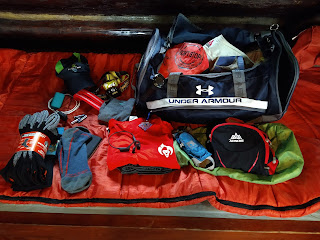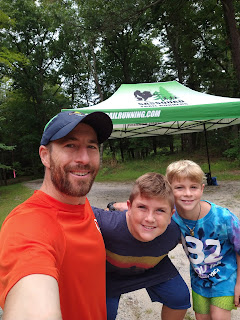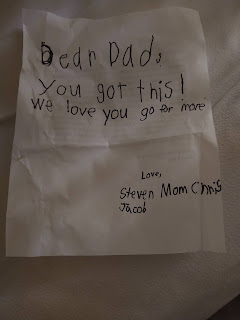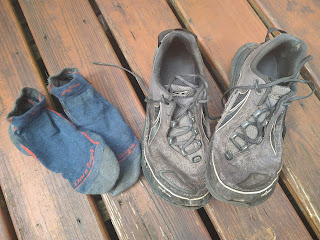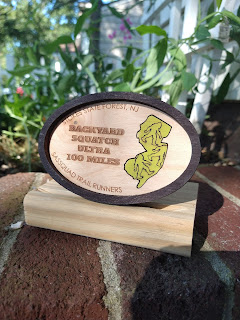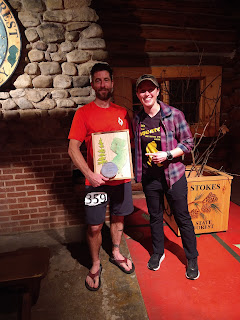The story of the race starts about a week before the actual race when I packed the car to head out on a week long camping trip with the family leading up to race weekend. You could say the story starts long before that with when I decided to give up smoking and replace it with running, but that’s a much longer story than I intend to tell in this report. So, I’ll stick with the camping trip the week before the race.
Plans for both the camping trip and the race all fell into place about a month before they happened. The announcement for the race went public about a month before race day. It was only a matter of a week or two before we were informed that our family had been moved off the waitlist and had a spot at the YMCA family camp we we’re hoping to go to in Frost Valley, NY. It seemed to happen quickly and the timing felt serendipitous. Before I knew it, I had plans for a week of camping and a weekend of racing another backyard format ultra to close out the summer with a bang!
As NJ’s first official backyard format race, I was pumped to be a part of the Backyard Squatch Ultra! I had run Pennsylvania’s first official backyard format race, the Keystone Backyard Ultra, in May where I was the last person standing with 129 miles. I had also run two other backyards, Run Ragged 2019 and Last Idiot Standing 2019, where I was also the last person standing at both. With my streak of performances at backyards, I put a ton of pressure on myself to perform well and do everything within my ability to avoid a DNF at the Backyard Squatch.
I was a bit worried about my taper period coinciding with a week of camping. We did some hiking and I did a couple short runs during the camping trip and it ended up feeling like a really great taper week. I wasn’t inactive, but my legs got a rest from the normal number of miles they cover. Mentally, it was great for the week before the race to be away and be 100% focused on family time. Usually I get anxious the week leading up to a race, especially a race where I really want to push myself to perform well. With all the activities during the week of camping, I didn’t think about the race anywhere near the amount I would have during an otherwise normal week’s schedule. This was great for me as I felt refreshed mentally, spiritually, and physically before making the drive to Stokes State Forest where the Backyard Squatch was held.
Arriving at the race on Saturday morning felt like returning home after being away on a long trip. I hadn’t run a Sassquad Trail Running race in a couple years and the vibe and community that race director Kim Levinsky has built around her races, or “trail parties” as she calls them, is amazing. As far as I can tell, every runner there is made to feel special by the amazing group of Sassquad Trail Running volunteers.
The race used two courses, a mostly single track trail lollipop loop for daylight hours and a mostly paved road out and back for night laps, both starting from the Stony Lake Day Use Area. The trail loop was all runnable with a few more technical sections and a little under 400 feet of elevation gain. The trail loop started with a quick descent down to hop on a road for only maybe a few hundred feet to cross a bridge before getting back on a single track trail. The first mile was the stick of the lollipop and was a gentle, non-technical uphill on the way out. At the “Y” that started the loop of the lollipop the trail began to descend through a slightly technical section with some rocks but still runnable. The trail then dumped us out on a short, maybe half mile, rolling downhill section of road before turning back on to a trail. This was about the halfway point, roughly two miles, of the lap. The next half mile or so of trail felt more like a fire road with a gentle incline. It was runnable, but I always hiked it and ate a gel at that point. Then you crossed a small bridge and went through a little rock garden which was the most technical part of the course. From there it was mostly short, gentle ups and downs of non-technical single track until returning to the “Y” and having about a mile of gentle downhill that you cruise in on before making it back to the aid station.
I didn’t give it much thought before the race, but a good deal of runners switched from trail shoes to road shoes for the road course. I brought additional shoes and socks, but I was only intending to change if I was having any foot issues. Also, I was running in my Altra Timps which I typically use for my mixed road and trail runs so I figured I’d just use them as long as they kept feeling ok. Thankfully, they felt good for the entire race so I never changed my shoes or socks.
When daylight returned and we finished the 24th lap to complete 100 miles we had four runners left in the race. We were all greeted upon our successful completion of that lap with a true Sassquad trail party. There was a unicorn, a sasquatch, and a volunteer presenting us with a 100 mile buckle designed and crafted by Kim herself! Of the four runners, one was hitting the 100 mile mark for the first time ever and was dropping after that lap. Another just wanted to hit 100 and then improve his distance personal record a little more so he stuck around for a 25th lap (YEAH JIMMIE!!!). That left me and Justin Kousky still in the race. Prior to the race, I did a little Ultrasignup stalking and of everyone I stalked I had pegged Justin as the guy who would likely be one of the final two in the race. I had hoped I’d have a good day and I would be the other half of the last two standing and thankfully that’s how the race played out. So everything had gone as expected thus far, but based on Justin’s stellar Ultrasignup record and the many unsupported, lengthy FKTs he held, I had no idea what to expect after this point. I’ve heard it said that these backyard races don’t actually start until after the 24 hour mark, and I would say that is how it felt to me at the time.
My lowest point came between one of my laps during the second day, maybe around the 30 hour mark. My wife started telling me about what she had found out about Justin and how good of a runner he is with some really impressive wins and FKTs. I knew this already, but hearing her say it after a night without sleep and over 100 miles on my legs made the idea of going up against him in a last person standing race seem even more daunting. At the time, it felt like my wife was telling me that it’s ok to lose to him because I’m just outmatched. This led to some pretty negative thoughts in my head which is not a good way to be in a last person standing race. I began thinking that everyone there, including my wife and kids, was sure he was going to win. My oldest son had been enthusiastically telling me “You got this Dad!” between every lap. But when he said it this time it sounded sad and defeated like he didn’t believe it anymore. I believed that I was the last person there that thought I had a chance of winning. I went back out to run a lap with that thought in my head. When I got up to go back out for that lap, I said “I just have to keep running. I can control that. That’s all I can do.”
My outlook began to change at the next aid stop when I expressed my concerns out loud to my wife. When I told her this, she said that it wasn’t true. She went on to tell me that Kim had put out a call on Facebook to get more volunteers in because she was expecting the race to go into, if not through, a second night. It was also during this aid stop that Kim came over to my aid area to say that if I wanted any cooked food from the aid station just to let her know and she would get it for me. I asked for coffee. It was too hot to drink more than a few sips at that stop, but my wife loaded it up with sugar and let it cool so it was ready at my next stop. That next stop was a real mental turning point for me. I got a good deal of caffeine and sugar in me from the awesome coffee my wife prepped. I ate a piece of pizza that a glorious volunteer brought (THANK YOU!!!). My wife wiped down my legs, cleaning them of all the trail dust that had accumulated and stuck from all the trail miles. I felt more refreshed and ready to keep going on that 33rd or so lap than I had felt at pretty much any point during that second day.
Approaching the starting corral to head out for that lap I congratulated Kim. She didn’t know what I was congratulating her for at the time and gave me a confused look. I then explained, congrats for her race, NJ’s first backyard, as it had now officially gone longer than Pennsylvania’s first backyard race. We high fived and my mind was in a good spot again and I was happy. I was beginning to feel the wear and tear from the miles, but I was still enjoying them. I was floating through the trail section as easily as the first day; I found myself catching a toe and stumbling a few times. Once I nearly fell, but caught myself by putting my hand down in a patch of poison ivy which thankfully only led to a couple blisters on my wrist and not a full blown rash. I also knew we only had a few more trail laps left before we switched back to the road, and I was pumped to have that change of scenery and lowered concern for trip hazards to look forward to.
Of all the points of the race, my highest was the first road lap for the second night, my 35th lap. I drank more sugary coffee and ate a second piece of pizza just before heading out. I had over 141 miles on my legs, but they still felt ok and I knew they could at least get me through the night loops. I thought to myself “I’m only a 100k away from running my first 200 miler!” This had me pumped! And the icing on the cake, after eating pizza and turning my Aftershokz headphones back on, the song “Pizza Day” by the Aquabats came on! It was too perfect. It felt like everything was in perfect order. I was floating on the road, painlessly and almost effortlessly moving past my previous distance personal record of 129 miles. I was singing along to “Pizza Day” running on a NJ State Forest road in the dark just loving where life had led me.
With the switch back to the road course, my pace picked up. So did Justin’s, by a much greater degree than mine. It made me curious and wonder what he was up to. Was it a mind game? Maybe. Then I thought maybe he’s banking some time with the intention of sneaking in a quick nap before the next lap. At that point all I could do was guess. I would find out when I got back.
When I did get back with close to 10 minutes until the start of the next lap, I was shocked. My family and Kim were all standing under the tent that marked the starting line. They were all smiles and all cheered for me as I came in saying “way to go Scott!” I was confused. It was just another lap. We’d been doing this for over 30 hours. What the hell made this one different? That’s when they told me that Justin wasn’t going back out for the 36th lap. I didn’t believe it. He was looking too strong to stop. He had just run his last lap in about 44 minutes. I started questioning it and that’s when Justin spoke up. I hadn’t seen him where he was sitting just to the side of the tent in his chair. He said that he was done and was “officially throwing in the towel.” I started almost arguing with him, telling him can’t quit when he just hammered that last road lap. His mind was made up though. I gave him a fist bump and we chatted a bit, probably more than we had in the last 35 hours of running together. The competition was over and our game faces dropped. It felt like a sudden shift of attitudes towards each other. It felt like we almost instantaneously went from competitors to bros. I was thanking him for pushing me so far and he was telling me what a great competitor I was and how my race plan and execution was all on point. That’s what I love about this race format. It is SO competitive, but there is so much respect and admiration between the runners that are pushing one another to amazing performances. It felt great and I was loving the chat, but it had to be brief. I still had to get back out to complete one more lap.
 |
| My boys getting ready to mark my final lap as complete! |

